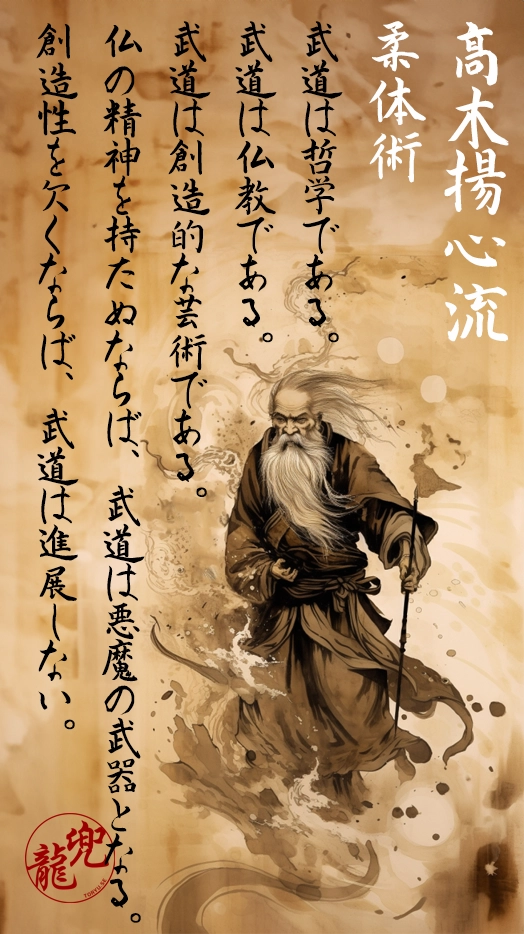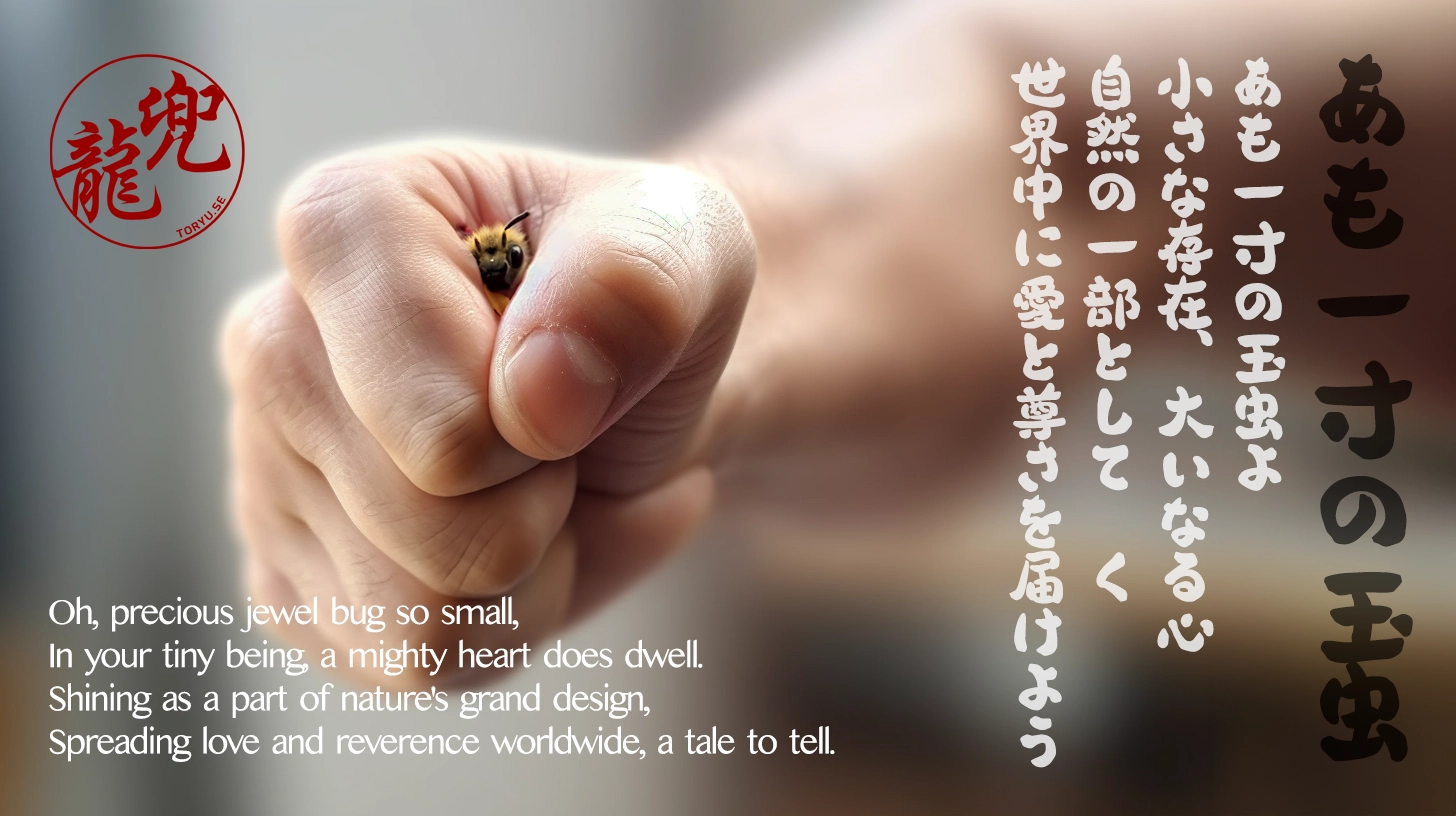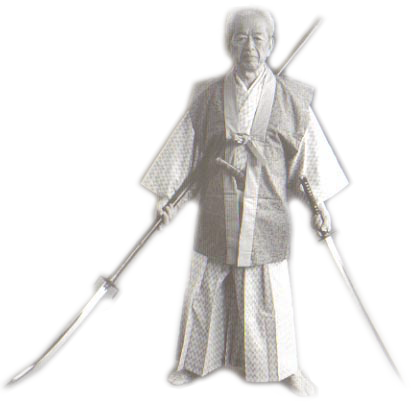柔体術
JŪTAIJUTSU
Takagiyōshin-ryū is a Jujutsu school; however, we refer to it as Jūtaijutsu to highlight the significance of the “Tai” (body) component. In essence, it retains the essence of traditional Jujutsu, yet we incorporate enhanced footwork techniques and harness power from the entirety of the body.
Martial Arts is not what most people think it is, you will never get the true meaning of Budō from Hollywood or media. Hatsumi Sōke once said. I’m not teaching how to fight. I’m showing control. If you try to fight then it’s a very low level of budo. Please learn to control.
Budō is a Philosophy.
Budō is Buddhism.
Budō is a creative art.
Without a spirit of Buddha,
Budō is a weapon of the devil.
Without creativity,
Budō will not advance

乱取稽古
RANDORI KEIKO
Upon acquiring the form and technique, the practitioner progresses to employing invisible movement. This involves strategically positioning oneself in the opponent’s blind spot, aiming to nullify their power instead of relying solely on one’s own strength. The objective is to disrupt their fighting prowess by causing their forces to collide. As a result, the technique transcends its original form, continuously evolving without limits.
The Gokui secret teachings of our Takagiyōshin-ryū Jūtaijutsu tradition contain a story about catching a bee. There is a power phrase that goes “Amo issun no tamamushi” By saying this mantra and grabbing a bee without hesitating, you will avoid being stung.

The phrase “あも一寸の玉虫” (Amo Issun no Tamamushi) is a poetic expression in Japanese. It can be interpreted as “a tiny jewel bug” or “a minuscule jewel beetle.” It portrays the image of a small insect with beautiful colors and shimmering wings. The phrase is often used metaphorically to represent something small or seemingly insignificant that possesses hidden beauty or value.
The techniques we study in Bujinkan Kaigōzan dōjō is the following…
高木揚心流柔体術
TAKAGIYŌSHIN-RYŪ JŪTAIJUTSU
表型
OMOTE KATA
1. 霞捕 KASUMI DORI
2. 洞返 DŌ GAESHI
3. 搦捕 KARAME DORI
4. 虚倒 KYOTŌ
5. 片胸捕 KATAMUNE DORI
6. 両胸捕 RYŌMUNE DORI
7. 追掛捕 OIKAKE DORI
8. 戒後砕 KAIGO KUDAKI
9. 行違 YUKICHIGAI
10. 唯逆 YUIGYAKU
11. 乱勝 RANSHŌ
12. 拳流 KEN NAGARE
13. 膝車 HIZA GURUMA
裏型
URA KATA
1. 水月 SUIGETSU
2. 逆腕 GYAKU UDE
3. 腕折 UDE ORI
襟締型
ERI-JIME KATA
1. 本締 HON JIME
2. 逆締 GYAKU JIME
3. 腕締 UDE JIME
4. 一摘締 ITTEKI JIME
5. 痛締 ITAMI JIME
6. 押締 OSHI JIME
7. 逆押締 GYAKU OSAE JIME
8. 坐締 SUWARI JIME
捌型
SABAKI KATA
1. 片胸捕 KATAMUNE DORI
2. 両胸捕 RYŌMUNE DORI
3. 鬼砕 ONIKUDAKI
4. 背負鎌 SEOI GAKARI
5. 腰投鎌 KOSHINAGE GAKARI
6. 腕折 UDE ORI
7. 逆手投 GYAKUTE NAGE
8. 鬼門投 KIMON NAGE
9. 当投 ATE NAGE
10. 小蝶捕 KOCHŌ DORI
体之型
TAI NO KATA
1. 腰車 KOSHI GURUMA
2. 四ツ手 YOTSUDE
3. 四ツ手崩 YOTSUDE KUZUSHI
4. 刑頭 KEITŌ
5. 腰折 KOSHI ORE
6. 腰流 KOSHI NAGARE
7. 雲井返 KUMOI GAESHI
8. 両手掛 RYŌTE GAKE
9. 水流 MIZU NAGARE
10. 雪柳 YUKI YANAGI
11. 越後崩 ECHIGO KUZUSHI
12. 鵲 KASASAGI
13. 票墜 HYŌTSUI
14. 蔦搦 TSUTA GARAMI
15. 瀧落 TAKI OTOSHI
無刀捕型 (武十捕十字論)
MUTŌ-DORI KATA
(MUTŌ-DORI JŪJIRON)
1. 拳者捕 KENJA DORI
2. 一文字 ICHIMONJI
3. 柄落 TSUKA OTOSHI
4. 向捕 MUKO DORI
5. 廻捕 MAWASHI DORI
6. 後捕 USHIRO DORI
7. 沈捕 SHIZUMI DORI
大小捌型
DAISHŌ SABAKI KATA
1. 柄砕 TSUKA KUDAKI
2. 引捕 HIKI DORI
3. 入捕 IRI DORI
4. 乱岳 RANGAKU
5. 掬捕 SUKUI DORI
6. 桝骨 MASUBONE
7. 潮返 USHIO GAESHI
8. 掛落 KAKE OTOSHI
9. 小手止 KOTE DOME
10. 横刀 YOKO GATANA
11. 車投 KURUMA NAGE
12. 四ツ手刀 YOTSUDE GATANA
13. 刃結 YAIBA MUSUBI
14. 透捕 SUKASHI DORI
調型
SHIRABE KATA
1. 梅吐 UME HAKI
2. 車返 KURUMA GAESHI
3. 天返 TEN GAESHI
4. 流捕 NAGARE DORI
潜型
MOGURI KATA
1. 極楽落 GOKURAKU OTOSHI
2. 地獄捕 JIGOKU DORI
3. 玉砕 TAMA KUDAKI
4. 飛鳥捕 HICHŌ DORI
5. 鬼伏 ONIBUSE
6. 稲妻捕 INAZUMA DORI
7. 水鳥 MIZUTORI
8. 来雪 KURU YUKI
9. 体落 TAI OTOSHI
10. 潜捕 MOGURI DORI
11. 潜投 MOGURI NAGE

“In a life Tens of Hundreds of ways are there, keep walking only on the way of truth.“